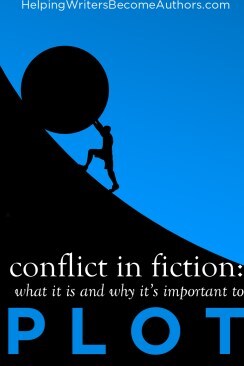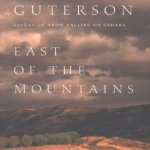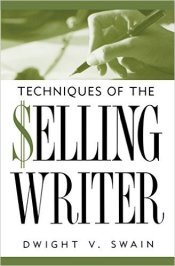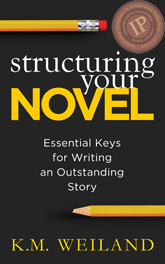Conflict in Fiction: What It Really Is and Why It’s Important to Plot
 Conflict is one of the central engines of story. We’ve all heard it: no conflict, no story. On the surface, that makes total sense. But I find there can be a lot of confusion around the word “conflict.” What is conflict in fiction really? What is its purpose? What does it look like in a scene? And how can you use it in all types of stories?
Conflict is one of the central engines of story. We’ve all heard it: no conflict, no story. On the surface, that makes total sense. But I find there can be a lot of confusion around the word “conflict.” What is conflict in fiction really? What is its purpose? What does it look like in a scene? And how can you use it in all types of stories?
Years ago, I remember reading an interview with a famous author, in which he explained that one of his secrets to writing a successful story was to double check that he had included conflict on every page. I dutifully underlined the sentence, but it always confused me a little bit. What about pages that described the characters’ travels? Or what about pages where the dialogue was mostly relational? What about love scenes?
For that matter, what about whole stories in which, practically speaking, not much happens? Two high-altitude examples off the top of my head: David Guterson’s East of the Mountains and Charles Frazier’s Cold Mountain. These two acclaimed novels are both literary-style stories that are mostly existential in nature. Stuff happens; there is a plot; but with a few exceptions, there really isn’t much in the way of what we generally consider to be conflict.


So how can these stories work? For that matter, how can they, by the classical definition, be stories at all?
The answer is all in how you define “conflict.”
What Is Plot Conflict?What comes to mind when you hear the word “conflict”? You might think of physical altercations or even outright violence. At the least, whatever you’re currently picturing very likely involves confrontation.
It’s natural enough for our modern, western minds to conflate conflict and confrontation when we consider fiction. This is because in most stories and most scenes, conflict does manifest in some sort of confrontation, whether it’s subtextual, verbal, or physical. Everything from passive-aggressive staring contests on up to intergalactic wars. That’s conflict.
But to limit our understanding of plot conflict to merely confrontation is problematic on a number of levels. For starters, it is just too simplistic. As noted, many wonderful stories from many traditions will prove this thesis wrong at a glance. More than that, it’s worth considering that this overemphasis of confrontation (especially in its almost ubiquitous pairing with violence) equally reflects and generates a cultural emphasis on the same.
There’s nothing wrong or incorrect in using confrontation to create plot conflict. But to understand conflict as confrontation is much too narrow a definition.
Indeed, what I personally deem the most useful perspective is that of conflict as obstacle. Confrontations can and often do create obstacles, but even more often they result from the obstacles. Therefore, conflict as a generator of plot is much less about the possible emergent of a confrontation and much more about the occurrence of obstacles to the characters’ forward progress toward their goals.
Understanding How Goal/Conflict Function in PlotLet’s go meta for a second and consider why it is that we even need conflict in fiction at all. Why is it such a big deal?
One of the simplest ways to examine this question is to boil plot down to one of its smaller integers—the scene. How does plot work on the scene level? And how does conflict factor in?
>>Click here to read more about scene structure.

Techniques of the Selling Writer by Dwight V. Swain (affiliate link)
Although there are many ways to examine scene structure, one of my favorite remains Dwight V. Swain’s classical approach, which breaks scene down into causal halves: Action and Reaction. Put practically, this simply means: The Character Does Something and Something Happens.
From there, we can break the scene down further. The Action half, which is where the majority of plot movement happens, can be broken down into three parts: Goal, Conflict, Outcome.
To fully understand how conflict works on both the scene and plot level, we first need to make sure we understand how “goal” works. Just as the word “conflict” tends to evoke immediate but limited ideas of its scope, so too “goal” often creates associations with ambition, focused drive, and specific plans. When this is how “goal” is used in a scene or story, the “conflict” that follows very often will be confrontational in nature.

Structuring Your Novel (Amazon affiliate link)
However, a broader understanding of the word “goal” might be more along the lines of “intention” or even “direction.” What “goal” really indicates is simply the character’s forward motion—which will then be met by an obstacle of some sort that will require re-calibration—aka the Outcome of the scene.
The Goal/Conflict pairing in a scene might easily and successfully translate into a character’s plan to rob a bank, which then leads to a confrontation with police. But it can just as accurately be represented by a character who gets up in the morning with the intention of making breakfast, only to be blocked by the obstacle that there’s no food in the refrigerator.
At first glance, we’re talking about vastly different types of story here. But in fact even most race-‘em-chase-‘em, plot-centric stories will include well-structured and integral scenes in which the Goal and Conflict remain ordinary and even subtextual.
What Is the Purpose of Conflict in Fiction?Conflict keeps the story moving. Just as in life, characters are always moving toward something—whether that something is specific or vague. It may just be getting through the day so they can go back to bed and start over. Regardless, there is always forward momentum. There is always an underlying need that keeps humans moving. And that need is created by either conflict or the threat of conflict—by the suggestion that there may be obstacles between us and what we need to survive.
No food in the fridge means our characters have to find another way to feed themselves. And even if they do have enough food in the fridge to keep themselves successfully fed for another few hours, a new need will immediately arise as soon as they’ve put their forks down: now they have to do the dishes, dress for work, use the bathroom, etc.
It’s true most of the time, these mundane “goals” and “conflicts” will not be enough to keep readers’ interest. After all, readers probably get their fill of solving these sort of problems in their own lives. They probably just finished their own breakfast dishes before picking up your book.
And this is why most stories raise the stakes.
As in Cold Mountain (which is, in fact, mostly about one of the main characters attempting to fill her larder with food), the stakes in fiction will usually be closer to life and death than just about whether or not the character has to walk down the street to buy more eggs.

And that is where confrontation often enters the picture. The higher the stakes in a story, the more important even mundane daily intentions become. Those intentions become concrete and specific goals because of their importance to the character. The more important the character’s goals, the more dangerous any obstacle to that goal becomes. And the more dangerous the obstacle, the more likely the character will be willing to engage in confrontation to achieve that goal.
The Importance of Understanding “Conflict” in FictionI still think “conflict” is a good term. It’s evocative after all. Just saying it immediately brings up possible scene ideas. Plus, it’s ubiquitous in the writing world.
But it’s also important not to limit its definition too strictly. Doing so inevitably limits our understanding of story itself. Ultimately, “conflict” is just a word used to describe the things that happen to our characters to change their trajectory to whatever degree. By that definition, conflict is the welcome but surprising kiss between two characters, just as it is the toilet paper stuck to one character’s shoe before a big meeting, and just as it is one character arguing with another or even socking the other in the nose.
In short, it’s a sliding scale. By not boxing “conflict” into the idea that it must always indicate “confrontation,” we can also avoid boxing our stories into limited forms. Although the terms “goal” and “conflict” aren’t going away, you may find it helpful to at least keep it in the back of your mind that “intention” and “obstacle” are just as valid and, in fact, perhaps more accurate ways to view the abstract mechanics of plot.
Wordplayers, tell me your opinions! What do you think is a good definition for conflict in fiction? Tell me in the comments!Click the “Play” button to Listen to Audio Version (or subscribe to the Helping Writers Become Authors podcast in Apple Podcast or Amazon Music).
___
Love Helping Writers Become Authors? You can now become a patron. (Huge thanks to those of you who are already part of my Patreon family!)The post Conflict in Fiction: What It Really Is and Why It’s Important to Plot appeared first on Helping Writers Become Authors.




